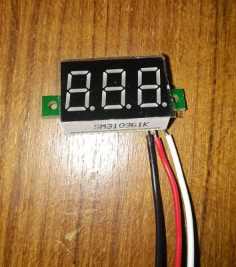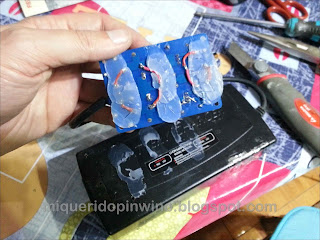 |
| 42V DC Power 19V 2A regulated DC to charge a laptop that spends 3A |
In this post we will see how to feed these appliances we have at home, whose power supplies had stopped working and left, forgotten, in a drawer.
For example, that portable power supply can have a second life and continue feeding any device that requires a power exceeding the capacity (watts) of the transformer. While we maintain the amps equal or exceeding the needings by the apparatus we want to power, we just have to make sure that the voltage output is the same or little less of your device needs.If for example we need an e-bike charger, or need a charger of a given voltage, we can adapt economically the output voltage: This is where the boosters and converters come into play modifying voltage DC to DC.
150W upconverter
 |
| It has entrance and exit to one side and a small screw adjustment (right) which regulate the output voltage |
At least that's what they say hold on, but I guess that's the peak power; more than 60W will need a fan to cool the heat sinks or burn soon. There are other available similar, higher or lower power, better or worse designed, but the operating principle is the same.
Characteristics:
- DC input of 10 to 32V to an output of between 12-35V (with a source of 12VDC can obtain regulated 30V output).
- Up to 60W , for more power, better put a small fan heatsinks. From start to appreciate 30W a slight noise (similar to a large transformer) capacitors from working.
- Based on the micro UC3843 , which controls the modulation on demand.
- A MOSFET (diode) to feed the capacitor, and a voltage regulator are responsible for doing all the work.
- He carries a large capacitor both input and output to eliminate crimped by high frequency.
- No reverse polarity or fry quickly;).
Martin Jones has made an in deep analysis of this model on this page , and in short, it is an elevator that takes advantage of the ability of a coil to store energy, which is "loaded" during one of the states, and then empty adding the line voltage to be serially, increasing the available voltage, the second state. It is best explained in the Wikipedia .
I've added it to reduce twisting when asked a lot of power, a pair of capacitors over the same type as those carried by connecting the rear (then put them a longer cable to take them to the top and not stick with the transformer where use):
Keep in mind that does not have any protection; or reverse polarity, or temperature, or overload, or anything , so you have to consider not exceed 50W or else we have to put a fan.
I needed a transformer between 27 and 29V to feed my LiFePO4 battery 24V (8 cells in series) and between 300 and 500 mAh for load control properly sway cells, and I have built from source DC 12V 1Ah, which raised with this converter, and taking into account that will have an efficiency of 85% or so, we will give the 375mAh output :
Origin 12V * 1A = 12W
12W / 27.2V * 0.85 (sc.) = 0,375Ah Output
With what I recharge the battery half in 16 hours (capacity 6Ah / 0.375Ah load), ideal for leave loading afternoon until the next day.
I have peeled encintándolo on the transformer; as verify that it works, it is best to isolate it well, but there is no security problem because the maximum voltage of 35V will be, which is a safe voltage (<50v div="">
I've added output LED voltmeter 3 to 100V DC to verify that the voltage does not vary much (potentiometer regulation is not very stable to say, may vary 0.5V). White power cable indicator has a maximum of 35V (place a resistance line voltages with us to handle), and carries a small potentiometer that can calibremos and error to come up with 0.3V:
 |
| LED voltage indicator of Chinese economic 2,8-100V |
 |
| This LED can work between 2.8 and 90V |
Update: At the end of the transformer did notenough "chicha" to power the bike, so I put a feeder for LED lamps 900mAh and 30VDC to load with a voltage regulator regulated to 30V, making the charge to 28V ( balancer circuit requires a higher voltage for losses). Thus the charge to a maximum of 90% (it did not matter we charge 100% not the regulator would be necessary, give between 30 and 32V balancer work well).
In addition it is perfect for outdoors as part of the high voltage is encapsulated inside with epoxy resin under the IP65 standard :
90W downconverter
Happy modifications!
More info:
Converters DC DC
150W Boost Converter









No comments :
Post a Comment